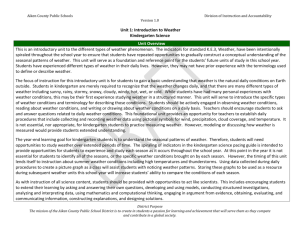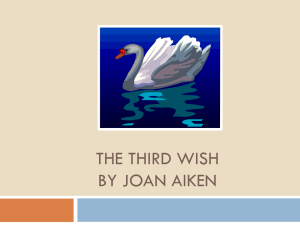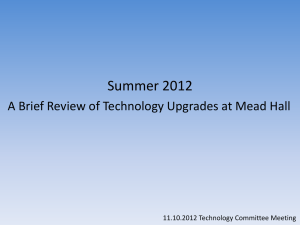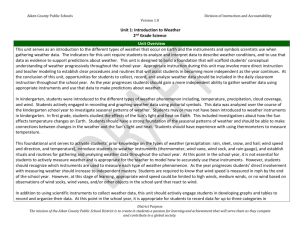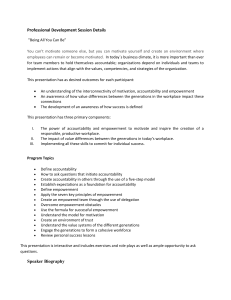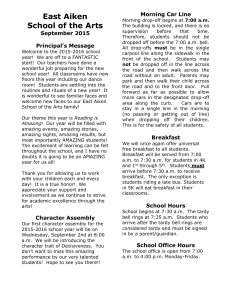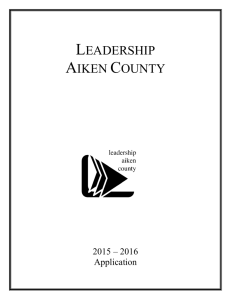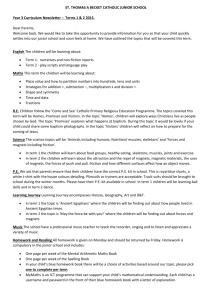Unit 7 Organizer - Kindergarten Science
advertisement
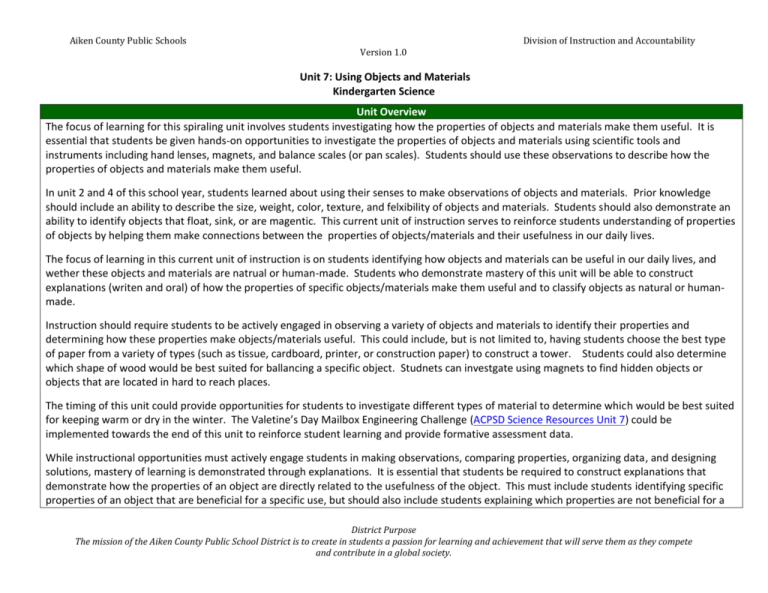
Aiken County Public Schools Division of Instruction and Accountability Version 1.0 Unit 7: Using Objects and Materials Kindergarten Science Unit Overview The focus of learning for this spiraling unit involves students investigating how the properties of objects and materials make them useful. It is essential that students be given hands-on opportunities to investigate the properties of objects and materials using scientific tools and instruments including hand lenses, magnets, and balance scales (or pan scales). Students should use these observations to describe how the properties of objects and materials make them useful. In unit 2 and 4 of this school year, students learned about using their senses to make observations of objects and materials. Prior knowledge should include an ability to describe the size, weight, color, texture, and felxibility of objects and materials. Students should also demonstrate an ability to identify objects that float, sink, or are magentic. This current unit of instruction serves to reinforce students understanding of properties of objects by helping them make connections between the properties of objects/materials and their usefulness in our daily lives. The focus of learning in this current unit of instruction is on students identifying how objects and materials can be useful in our daily lives, and wether these objects and materials are natrual or human-made. Students who demonstrate mastery of this unit will be able to construct explanations (writen and oral) of how the properties of specific objects/materials make them useful and to classify objects as natural or humanmade. Instruction should require students to be actively engaged in observing a variety of objects and materials to identify their properties and determining how these properties make objects/materials useful. This could include, but is not limited to, having students choose the best type of paper from a variety of types (such as tissue, cardboard, printer, or construction paper) to construct a tower. Students could also determine which shape of wood would be best suited for ballancing a specific object. Studnets can investgate using magnets to find hidden objects or objects that are located in hard to reach places. The timing of this unit could provide opportunities for students to investigate different types of material to determine which would be best suited for keeping warm or dry in the winter. The Valetine’s Day Mailbox Engineering Challenge (ACPSD Science Resources Unit 7) could be implemented towards the end of this unit to reinforce student learning and provide formative assessment data. While instructional opportunities must actively engage students in making observations, comparing properties, organizing data, and designing solutions, mastery of learning is demonstrated through explanations. It is essential that students be required to construct explanations that demonstrate how the properties of an object are directly related to the usefulness of the object. This must include students identifying specific properties of an object that are beneficial for a specific use, but should also include students explaining which properties are not beneficial for a District Purpose The mission of the Aiken County Public School District is to create in students a passion for learning and achievement that will serve them as they compete and contribute in a global society. Aiken County Public Schools Division of Instruction and Accountability Version 1.0 specific use or why an object is not best suited for a specific use. Students should use words such as stronger, harder, heavier, more flexible, lighter, softer, thinner, or thicker when comparing the attributes of multiple objects and materials. In quarter three math students will continue working with sorting and representing data in object and pictures graphs. Additionally, quarter three math includes students investigating the measurable attributes of length and weight. This provides opportunities for students to esxperience integrated math and science. Green italized font included in the Know-Understand-Do (KUD) section of this document indicate occasions where math standards can and should be integrated. Integration of ELA standards for this includes having students use words and pictures to describe how properties of objects/materials make them useful (W.2.1). This should include having students create and label models that demonstrate the relationship between properties of objects/materials and their usefulness, and crafting sentences to describe this phenomenon. These models and sentences could be used to support students’ ability to make connections between illustrations and text (RL.6.1). As with instruction of all science content, students should be provided with opportunities to act like scientists. This includes encouraging students to extend their learning by asking and answering their own questions, developing and using models, conducting structured investigations, analyzing and interpreting data, using mathematics and computational thinking, engaging in argument from evidence, obtaining, evaluating, and communicating information, constructing explanations, and designing solutions. 2014 SC Academic Standards K.P.4: The student will demonstrate an understanding of the observable properties of matter. Targeted Learning Indicators K.P.4A.3: Conduct structured investigations to answer questions about which materials have the properties that are best suited to solve a problem or need. Recurring Learning Indicators K.L.2A.4: Analyze and interpret data to describe how humans use their senses to learn about the world around them. K.P.4A.1: Analyze and interpret data to compare the qualitative properties of objects (such as size, shape, color, texture, weight, flexibility, attraction to magnets, or ability to sink or float) and classify objects based on similar properties. K.P.4A.2: Develop and use models to describe and compare the properties of different materials (including wood, plastic, metal, cloth, and paper) and classify materials by their observable properties, by their uses, and by whether they are natural or human-made. What students must know, understand, and do Know Understand Do Tasting in science should only Clear directions for a scientific investigation may include instructions Use scientific tools (hand lenses, be done with the permission to: magnets, balance scales/pan Develop a testable question. scales) to make observations. District Purpose The mission of the Aiken County Public School District is to create in students a passion for learning and achievement that will serve them as they compete and contribute in a global society. Aiken County Public Schools Division of Instruction and Accountability Version 1.0 of the teacher under controlled conditions. There are five senses, each with specific parts of the body (sensory organs) responsible for each of the five senses. Eyes: The sensory organs that see. o They take in information (for example, shapes, colors, size or movements) about the world. Nose: The sensory organ that smells odors and is a big part of why a person is able to taste things. Ears: The sensory organs that collect sounds. o The part of the ear that can be seen collects the sounds a person hears. o There are other parts inside that help with hearing. Tongue: The sensory organ responsible for taste. Skin: The sensory organ that is responsible for the sense of touch (including shape, texture, and hardness). Predict possible outcomes. Identify appropriate tools, instruments, materials, and procedures. Make quantitative observations (see K.P.4A.1). Record and represent data and observations Communicate observations (for example through verbal discussion, pictures, diagrams, note-booking, etc.) To make a prediction: Make observations and think about what is known about the object or event. Tell what will happen next. For example, using processes described above, have students determine which material would best keep your head dry when it is raining outside (i.e. size, shape, and composition). The following is information that was presented to students in Unit 2 and 4 of this school year. This knowledge serves as a foundation for learning in this current unit and students should apply this prior knowledge as they conduct structured investigations on using objects and materials. Making observations is a way of learning about the world around us. A scientific observation is one that anyone can make and the result will always be the same. o Example: the plant is green, has three leaves, and feels smooth. An observation that is not scientific, or an opinion, is one that not everyone may agree on. o Example: the flower is pretty. Observing helps to find out about objects (their characteristics, properties, differences, similarities) and events (what comes first or last, or what is happening at a particular moment). Conduct structured investigations to determine which properties of an object are best suited for a specific purpose. (K.MDA.1) Construct explanations to describe why the properties of a given object make it useful (W.2.1). Compare the properties of various objects to identify the most useful object for a given purpose. Compare different types of paper (or wood, plastic, or metal) to determine which would be best suited for a given purpose. Construct explanations to describe how magnets can be used to retrieve metal objects (W.2.1). Develop models (object and picture graphs) to organize and display data from observations. (K.MDA.4) Develop and label models to demonstrate the relationship between the properties of objects and materials and their usefulness (RL.6.1) Construct explanations to compare the relative weight and length of objects. (K.MDA.2) (W.2.1) Conduct structured investigations to describe and compare the District Purpose The mission of the Aiken County Public School District is to create in students a passion for learning and achievement that will serve them as they compete and contribute in a global society. Aiken County Public Schools Division of Instruction and Accountability Version 1.0 o It covers and protects everything inside the body. o The skin holds everything together. o It also helps keep the body at just the right temperature. Qualitative (observable) properties are properties that can be distinguished through observing with the senses. Materials can be natural (e.g., sticks or twigs) or humanmade (e.g., plastic bottles). Materials have a variety of uses (e.g., wood---furniture, toys, pencils) Domain specific vocabulary. Observing does not mean just looking at something. It involves the use of one or more of the five senses. Objects are made of different materials. Different materials have different properties. Properties that can be used to describe, compare, and classify objects are size, shape, color, texture, weight, flexibility, attraction to magnets, or the ability to sink or float in water. Size: Objects can be classified by size when compared with other objects. Shape: Objects can be classified according to their basic shape including triangle, rectangle, circle, hexagon, and square. Color: Objects can be classified by their color. Texture: Describes the way something feels to the touch. Examples of texture words include soft, hard, rough, and smooth. Weight: At this level, students can compare the weight (quantity of mass) of one object to another by using a pan balance o They are not required to actually measure the weight of the objects, but can explain that one object is heavier/lighter than another. Flexibility: the ability of an object to bend, especially without breaking. o Objects can be classified by their flexibility. Magnetic attraction o Magnets are attracted to objects that contain iron. o Magnets ARE NOT attracted to all metallic-looking objects. o Objects can be classified as magnetic or not magnetic based on whether or not a magnet is attracted (sticks) to it. Sinking: when an object placed in a liquid stays near the bottom of the liquid. Floating: when an object placed in a liquid stays near the top of the liquid. properties (size, shape, color, weight, texture, flexibility, attraction to magnets, and ability to sink or float) of objects and materials including wood, plastic, metal, cloth, and paper. Use mathematical (graphs/charts) thinking to collect, organize, and analyze observations of objects/materials. K.MDA.4 NOTE TO TEACHER: This may be an appropriate opportunity for students to sort and classify data into 2 or 3 categories with data not to exceed 20 items in each category. Analyze and interpret data from observations of properties to describe, compare, or classify objects/ materials. K.MDA.4 Develop and use models (drawings and graphic organizers) to describe, compare, and classify objects/materials based on observed properties. Engage in scientific argument using evidence to describe how the properties of objects or materials make them useful. Read about, write about, and discuss properties of objects and materials. District Purpose The mission of the Aiken County Public School District is to create in students a passion for learning and achievement that will serve them as they compete and contribute in a global society. Aiken County Public Schools Division of Instruction and Accountability Version 1.0 Materials from which objects are made can include wood, plastic, Ask questions about the properties metal, cloth, and paper. of objects/materials. Similarities and differences between these materials can be made based on their properties, uses, and how they are made (i.e. made naturally or made by humans). SCIENTIFIC TOOLS used to describe observable properties include a hand lens, a balance, and magnets. Enduring Understanding Overarching Essential Questions Different properties of objects are suited for different The overarching questions are based on the targeted learning indicators for this purposes. unit. Students should be able to answer these questions by the end of this instructional unit. testable prediction tools record question outcomes instrument represent materials shape magnetic magnifying lens hexagon charts metal models objects color float triangle circle wood paper classify Overarching Questions: What properties of objects and materials make them useful? Domain - Specific Vocabulary scientific predict data test procedures quantitative communicate Recurring Domain-Specific Vocabulary properties size texture weight sink observe rectangle square data graphs plastic cloth natural human-made investigation patterns Cross Cutting Concepts (CCCs) District Purpose The mission of the Aiken County Public School District is to create in students a passion for learning and achievement that will serve them as they compete and contribute in a global society. Aiken County Public Schools Division of Instruction and Accountability Version 1.0 Cross Cutting Concepts (CCCs) are reoccurring themes that are evident in all domains of science and engineering. They transcend the boundaries of disciplines and serve to help students create a framework for connecting knowledge across disciplines. Instruction of CCCs should not be isolated, but rather teachers must plan to include intentional references to the CCCs within their science instruction. The following Cross Cutting Concepts and a description of their relevance to this unit of study have been identified: Patterns: Objects can be classified based on the patterns of their properties. Structure and Function: The properties of objects and materials make them useful for different purposes. * Other CCCs are intentionally omitted from this unit. Resources Content Resources: Valentine Mailbox Engineering Challenge (ACPSD Curriculum Map resource) Paper Building Blocks (recommended use with a variety of types of paper) Building with Paper (recommended use with a variety of types of paper) Literature: Granowsky, A. (2001). Big and Small. Connecticut: Copper Beech Books. ISBN 0-7613-2457-7 This book explains “big” and “small” and give examples. Granowsky, A. (2001). Colors. Connecticut: Copper Beech Books. ISBN 0-7613-2458-5 Colors are taught through pictures and text. Granowsky, A. (2001). Shapes. Connecticut: Copper Beech Books. ISBN 0-7613-2462-3 Shapes are described and examples shown. Hoban, T. (1984). Is it Rough? Is it Smooth? Is it Shiny? New York: Greenwillow Books. ISBN 0-688-03823-9 District Purpose The mission of the Aiken County Public School District is to create in students a passion for learning and achievement that will serve them as they compete and contribute in a global society. Aiken County Public Schools Division of Instruction and Accountability Version 1.0 Reidy, H. (2005). All Sorts of Shapes. Minnesota: Picture Window Books. ISBN 1-40481-061-7 Compares a variety of objects to others with the same shape, such as bubbles and scoops of ice cream, bricks and ice cubes, and bicycle wheels and pizza. Sargent, B. (2005). How Heavy is It? New York: Children’s Press. ISBN 0-516-25368-9 Lexile Level 480 This book explains how much things weigh. Career Connections Scientist A person who uses specific practices and systems to study the world around us. There are many different kinds of scientists that specialize in a specific field such as environmental, chemical, biological, or physical science. Engineer A person who uses specific practices and systems to design solutions and devices to solve problems. There are many different kinds of engineers that specialize in specific fields such as electrical, biological, and mechanical engineering. District Purpose The mission of the Aiken County Public School District is to create in students a passion for learning and achievement that will serve them as they compete and contribute in a global society.
